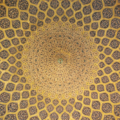 In this blog post, I’m going to discuss some possible theological ramifications of quantum physics’ wave particle duality. I’ll admit that these ideas may seem bizarre, yet they’re being circulated by some first-rate physicists, so deserve our consideration. It’s also helpful to remember that the strange is only strange until it’s been around for a while.
In this blog post, I’m going to discuss some possible theological ramifications of quantum physics’ wave particle duality. I’ll admit that these ideas may seem bizarre, yet they’re being circulated by some first-rate physicists, so deserve our consideration. It’s also helpful to remember that the strange is only strange until it’s been around for a while.
So first, a brief and extremely basic review of quantum physics:
In quantum physics, quanta particles respond to each other over vast spaces immediately—faster than the speed of light. This implies to some that they react on a dimension that’s at a faster or higher vibration than the physical dimension. This dimension has been dubbed hyperspace.
In addition, these fundamental particles possess the properties of both particles and waves. Only when we observe them does either property manifest. In a 2015 Smithsonian Magazine article*, author Colin Schultz elaborates, “The world is one of probabilities. Electrons seem to exist in a cloud of possibilities, inhabiting an area but no particular space. It isn’t until you look, that this aura of probability collapses and the electron inhabits a particular place (and manifests on the material level.)”
To some, the latter implies the integral role of consciousness to existence. In other words, reality doesn’t cause consciousness, rather, consciousness causes reality.
To Dr. Hans-Peter Dürr, former head of the Max Planck Institute for Physics in Munich, it also implies that the dualism inherent to the subatomic world is not limited to it, but extends through everything. For instance, he suspects that by thinking, the brain creates a dual field, and that this field continues to exist after the body expires (since the field—unlike the body, is not comprised of physical matter.) “What we consider the here and now, this world, it is actually just the material level…I have written my existence in this world on…the tangible. (By this he means his brain, which he compares to “a sort of hard drive”). “But I have also transferred this data onto the spiritual quantum field.”
In sum, he and several other eminent physicists believe that quantum physics suggests a sort of “life after death” for two reasons:
- The concept of hyperspace—the hypothetical dimension of higher vibration, in which quanta particles operate at speeds beyond that of light (the highest speed in this dimension).
- The possibility that everything, including people, possesses a duality similar to the wave-particle duality of subatomic particles. In our case, it would be a body/non-body (soul) duality.
Granted, these are conjectures only, but everything was an idea at one point. So, with that in mind, let’s proceed to one more theological speculation related to wave particle duality: that of the Christian and Eastern concept of the avatar—a being who is both divine and human.
In the opinion of award-winning, nuclear physicist F. Russell Stannard, the duality of the avatar has its parallel in quantum physics, in which, as I’ve been describing, entities thought of as particles can also act as waves, and in which light, considered a wave, can in some experiments act like particles. Therefore, in his mind, the concept has scientific credibility.
Again, although it may seem as if Stannard has played leap frog over more than a few integral steps in the equation, remember that while I’m just stating his conclusion, a more in depth explanation for his theories can be found in his many books, among them, The End of Discovery and The God Experiment. A blog post does not a ground-shaking dissertation make.
In conclusion, this entire topic really all boils down to the question of why there is Something rather than Nothing. Theologians and secularists have occupied their opposing sides for years, each launching insults at the other; neither of them yielding an inch. This is not altogether surprising, since arguing rarely convinces anyone. But science, on the other hand, the darling of the Enlightenment –now that at least has a fighting chance.
*”What if There’s a Way to Explain Quantum Physics without the Probabalistic Wierdness?”, Smithsonium.com, 2014.
